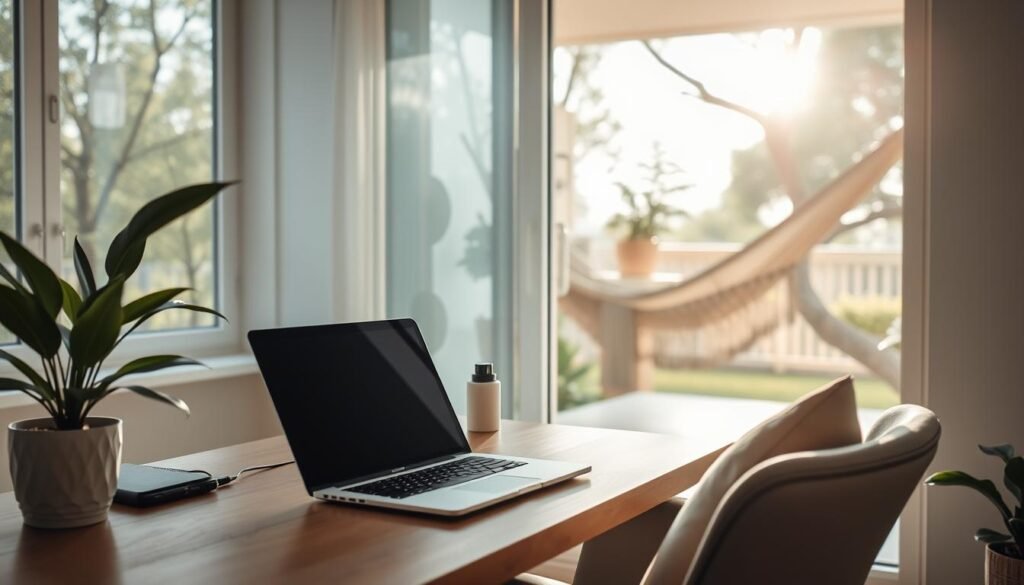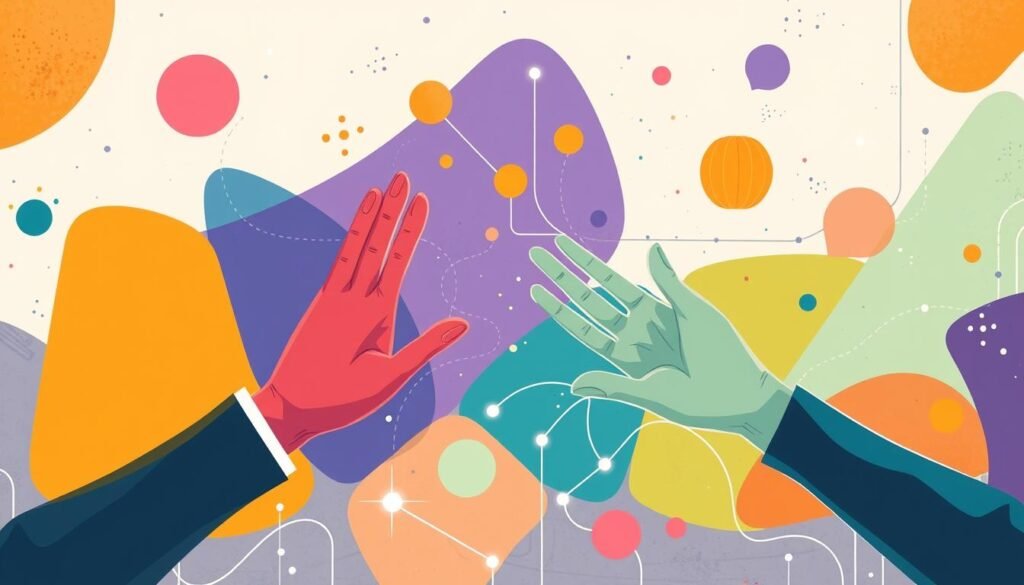Did you know over 60% of U.S. employees struggle with work-life balance1? This shows how urgent it is to find good strategies for balancing work and life in our digital world. Modern life makes it harder than ever to find harmony between work and personal life.
The digital age has changed how we work and live, mixing our professional and personal lives. With more people working from home, nearly 70% of the U.S. workforce did so during the pandemic1. This big change makes it even more important to learn how to balance our lives digitally.
In this article, we’ll look at three key strategies for thriving in today’s fast-paced digital world. We’ll talk about setting boundaries, managing digital overload, and taking care of ourselves. By using these Work-Life Balance Essential Strategies, you can better handle modern life and find more joy in your work and personal life.
Key Takeaways
- Over 60% of U.S. employees struggle with work-life balance
- Remote work has increased from 20% to 70% during the pandemic
- Setting clear boundaries is crucial in the digital age
- Managing digital overwhelm is key to maintaining productivity
- Incorporating self-care practices enhances overall well-being
- Effective strategies can help achieve work-life harmony
- Adapting to digital challenges is essential for personal and professional growth
Understanding the Digital Age and Its Impact on Work-Life Balance
The digital age has changed how we work and live. It brings new challenges to balancing work and life. Technology is always with us, mixing our work and personal lives.
The always-on culture
In today’s world, we feel pressure to be available all the time. A huge 85% of workers struggle to keep a healthy balance2. Smartphones and other devices make us work more than usual hours2.
Blurred boundaries between work and personal life
Remote work gives us flexibility but also mixes our work and personal lives. This mix causes 45% of employees to feel burned out2. A big 72% of people say they feel more stressed trying to handle work and personal life3.
Information overload and its effects
The digital age gives us too much information. This can make us less productive and more stressed. To fight these issues, 30% of people take digital breaks2. Also, 81% of people want wellness programs from their employers to help them stay balanced3.
It’s key to understand these effects to find ways to succeed in our digital world. By knowing these challenges, we can take back our time and find a better balance between work and life.
The Significance of Achieving Work-Life Harmony
Work-life harmony is key for our overall well-being and career success. It helps us balance our responsibilities, leading to better health. A 2020 Harris Poll found that 70% of people see work as a major stress4.
By achieving balance, we can reduce stress and avoid burnout5.
Living a balanced life brings personal fulfillment. People who find balance become more productive at work and in their personal lives4. This balance boosts creativity and job satisfaction. Interestingly, 41% of workers choose their job for work-life balance over salary, a big change since the pandemic6.

Companies that support work-life balance attract and keep the best talent5. Losing an employee costs around £30,000 and takes 28 weeks to replace6. Companies with engaged employees see a 19.2% increase in operating income, while those with low engagement see a 32.7% decline6.
| Aspect | Impact of Work-Life Harmony |
|---|---|
| Mental Health | Reduces stress levels and improves overall well-being5 |
| Productivity | Increases both in professional and personal life4 |
| Employee Loyalty | Engaged staff are 2.5 times more likely to stay late if needed6 |
| Company Performance | Can lead to 52% improvement in operating income6 |
Work-life balance improves our overall well-being5. Taking regular breaks and vacations boosts productivity and reduces stress56. By focusing on work-life harmony, we can lead more fulfilling and sustainable lives.
Challenges in Maintaining Balance in a Digital World
In today’s digital age, keeping work and personal life balanced is tough. The constant need to stay connected can upset our balance and happiness. Let’s look at some big digital world challenges we face.
The Always-On Culture
Work and personal life are now mixed up. A huge 78% of people say they feel stressed, burnt out, and unhappy because of this7. The need to be always on can lead to too much work and tiredness.
Instant Communication Pressure
Now, we’re expected to answer quickly. 82% of workers say this pressure hurts their well-being7. This constant need for quick answers can make us anxious and take away our personal time.
Digital Distractions and Productivity
Digital distractions are a big problem for getting work done. 75% of workers say they struggle with these distractions, making their work less efficient7. Some people get caught up in online tasks, doing more than they meant to, for work or fun8.
https://www.youtube.com/watch?v=V2qa66iSmYk
| Challenge | Impact | Solution |
|---|---|---|
| Constant Connectivity | 78% experience stress and burnout | Set clear boundaries |
| Instant Communication | 82% feel pressure to perform | Manage expectations |
| Digital Distractions | 75% struggle with productivity | Use focus tools and techniques |
To fight these issues, 68% of workers are choosing flexibility in their work-life balance7. Also, 72% are using tools and techniques to cut down on digital distractions and boost productivity7.
Finding balance in our digital world isn’t about disconnecting entirely, but about creating intentional boundaries and practices that allow us to thrive both personally and professionally.
By knowing these challenges and using good strategies, we can handle the digital world and keep a healthy balance between work and life.
Work-Life Balance Essential Strategies for Modern Professionals
In today’s fast-paced digital world, modern professionals need effective work-life balance techniques to thrive. The traditional nine-to-five workday is fading as flexible options like remote work and compressed workweeks gain popularity9. These changes demand new essential strategies for maintaining equilibrium between professional and personal life.

One key strategy is setting clear boundaries. By defining work hours and personal time, professionals can create a structure that prevents work from encroaching on their personal lives. This approach is crucial, as employees with a good work-life balance work 21% harder than those who don’t9.
Effective time management is another vital technique. Implementing methods like the Pomodoro Technique can increase focus and productivity9. Additionally, setting SMART goals (Specific, Measurable, Achievable, Relevant, and Time-Bound) helps employees stay on track and manage their workload efficiently.
“The key is not to prioritize what’s on your schedule, but to schedule your priorities.”
Prioritizing self-care is essential for modern professionals. Encouraging practices such as regular exercise and healthy eating can significantly improve employee well-being and productivity9. It’s noteworthy that 55% of employees reported having unused vacation days at the end of the year, highlighting the need for better work-life balance awareness10.
| Strategy | Benefits |
|---|---|
| Setting Clear Boundaries | Prevents work encroachment on personal life |
| Effective Time Management | Increases focus and productivity |
| Prioritizing Self-Care | Improves well-being and productivity |
By implementing these essential strategies, modern professionals can navigate the challenges of the digital age, enhance their productivity, and achieve a healthier work-life balance. Remember, a balanced life leads to increased job satisfaction and reduced stress levels911.
Strategy 1: Setting Clear Boundaries in the Digital Workspace
In today’s digital world, setting boundaries is key for a healthy work-life balance. As a professional, I’ve learned that separating work and personal time is vital. It’s essential for success and well-being.
Defining Work Hours and Personal Time
Setting specific work hours is important for a structured routine. I work from 9 AM to 5 PM, with some flexibility. This helps me relax after work, reducing stress and improving my balance1213.
Creating a Dedicated Workspace at Home
More people work from home now, so a dedicated workspace is crucial. I have a separate office area. It helps me switch between work and home modes12.
Communicating Boundaries to Colleagues and Clients
It’s important to clearly communicate your availability in the digital world. I use Calendly to manage my schedule and set expectations. This keeps professional relationships strong while respecting my personal time. Being firm yet polite is key13.
By using these strategies, I’ve found it easier to balance work and life in the digital age. Building new habits takes time, but it’s worth it for long-term success and happiness13.
The Role of Time Management in Achieving Balance
Time management is key for balancing work and life. I’ve learned that planning well can change how we handle our jobs and personal time. Good time management boosts work and leaves room for fun.

It’s important to focus on what’s most urgent. The Eisenhower Matrix helps sort tasks and cuts down stress. Setting clear work hours helps avoid burnout and makes us happier and more productive14.
Time-blocking helps us stay focused. Many people find apps and tools key for balancing work and life14. These tools stop us from doing too many things at once, which slows us down.
“Time management is life management.”
Breaks are crucial. Short breaks every few hours can make us up to 31% more productive and better mentally14. Running for 15 minutes or walking for an hour daily can also lower depression risk by 26%14.
| Time Management Technique | Benefit |
|---|---|
| Eisenhower Matrix | Reduces stress |
| Time-blocking | Improves focus |
| Regular breaks | Boosts productivity |
| Physical activity | Enhances mental health |
Learning these time management skills can lead to a better life balance. We can enjoy both work and personal time more fully.
Strategy 2: Prioritizing Tasks and Managing Digital Overwhelm
In today’s digital world, it’s crucial to prioritize tasks. This helps keep a balance between work and personal life. By focusing on what’s important, you can stay productive and feel fulfilled15.
Techniques for Effective Task Prioritization
The Eisenhower Matrix is a great tool for sorting tasks. It categorizes them based on urgency and importance16. This method helps you focus on the most critical tasks, reducing stress.
Using Digital Tools to Streamline Workflows
Digital calendars and project management software are essential. They help you schedule tasks and improve your workflow16. By using these tools, you can automate routine tasks and have more time for important work16.
| Digital Tool | Purpose | Benefit |
|---|---|---|
| Digital Calendar | Task Scheduling | Time Management |
| Project Management Software | Workflow Optimization | Increased Productivity |
| Automation Tools | Routine Task Handling | Focus on Strategic Work |
The Importance of Breaks and Downtime
It’s important to set clear boundaries between work and personal life. I make sure to work only during specific hours. I also avoid work emails outside those times, unless it’s an emergency16.
Regular breaks and downtime are also key. They help prevent burnout and keep you focused. Remember, taking care of yourself is essential for a healthy work-life balance15. By using these strategies, you can manage digital overwhelm and find balance in your life.
The Impact of Physical and Mental Health on Work-Life Balance
Keeping work and personal life in balance is key to our happiness. Our physical and mental health are at the heart of this balance. Many workers worldwide struggle to find this balance, with nearly half of managers working over 40 hours a week17.

Poor work-life balance can have serious effects. In 2020, over 745,000 people died from working too much17. This shows how important it is to focus on our health. Ignoring our health can cause burnout, anxiety, depression, and addiction17.
Exercise is a great way to keep balance. It lowers stress and boosts mood by releasing endorphins18. People who exercise often feel happier, work better, and even earn more18. Even a little exercise, like 15-30 minutes a few times a week, can help a lot18.
Yoga or tai chi can calm the mind and improve focus18. Being in nature also lifts our mood18. Mixing cardio with strength training helps us stay mentally strong, which is vital for balance18.
A good balance not only prevents health problems but also boosts creativity and happiness17. Taking care of our health lets us be better with our loved ones and grow personally. This leads to a more satisfying life19.
“Achieving a sustainable equilibrium between professional and personal lives nurtures mental, emotional, and physical well-being, contributing to sustained peak productivity and overall fulfillment.”
It’s important to tailor your balance to your own needs. Everyone’s situation is different. So, figure out what stresses you, listen to your feelings, and make changes for your mental health17. This way, you can handle work better, reduce stress, and avoid burnout. You’ll live a more rewarding life at work and at home.
Strategy 3: Incorporating Self-Care and Wellness Practices
Self-care routines are key to balancing work and life in today’s fast world. Adding wellness practices to our daily lives can cut down stress and improve our well-being. In 2020, 73% of Americans became more aware of self-care, with 69% planning to do more of it20.
Mindfulness and Meditation Techniques
Mindfulness and meditation are great for reducing stress. They calm the mind, sharpen focus, and boost self-awareness. Just 10 minutes a day of meditation has helped me handle work better and keep balance.
Regular Exercise and Its Benefits
Exercise is essential for self-care. It’s good for the body and mind, improving mental clarity and emotional health. I try to exercise regularly, even with a simple walk during lunch.
The Importance of Quality Sleep
Good sleep is vital for thinking clearly and managing emotions. Making sleep a priority has boosted my productivity and happiness. Remember, too much work can cause stress or burnout, upsetting balance20.
| Self-Care Insight | Percentage |
|---|---|
| Americans who put others’ needs before their own | 67% |
| People who wish they spent more time on self-care | 68% |
| Increased consciousness about self-care in 2020 | 73% |
| Planning to incorporate more self-care | 69% |
Remember, self-care is personal and varies for everyone, based on lifestyle and preferences20. It’s important to find what works for you and stick to it. By focusing on self-care, we can become more resilient, productive, and happy.
Leveraging Technology for Better Work-Life Integration
Technology is key to balancing work and life. It helps us do tasks faster, giving us more time for ourselves. In finance, those who balance work and life well are 21% happier at work. This leads to better job retention and more productivity21.

The car industry has seen big benefits from using technology. Ninety-two percent of employees say it helps them manage work and personal life better21. This is true in other fields too. In tech, flexible work has made employees 43% happier and cut turnover by 27%21.
To better integrate work and life, try these tips:
- Use advanced platforms for teamwork and quick decisions22.
- Automate routine tasks in admin work22.
- Try well-being apps for mental health breaks22.
- Use remote tools like video calls and cloud services22.
In healthcare, technology has also made a big difference. Employee well-being apps have cut stress-related absences by 35%21. This shows how digital tools can help balance and reduce stress at work.
By using smart work solutions, we can work better and feel better. The goal is to use technology wisely for a better work-life balance.
The Importance of Disconnecting in a Connected World
In today’s digital world, taking breaks from screens is vital for our health. A digital detox can help lower stress and improve sleep. Research shows that being always connected can increase stress and harm our mental health23.
It’s important to disconnect mindfully to keep our work and personal lives separate. Many people, like a remote software engineer, set their phones to airplane mode at 7 p.m. This helps them draw a line between work and free time23.

Disconnecting has more benefits than just reducing stress. Taking breaks can make us more productive, creative, and happy at work24. Here are some ways to disconnect:
- Use time-tracking tools to monitor work hours
- Implement the Pomodoro Technique for focused work sessions
- Engage in offline activities like reading or exercising
- Practice mindfulness and meditation daily
Companies are starting to see the value in letting employees disconnect. Some have rules against work emails after hours. This helps employees focus on their personal lives and self-care, which is good for their mental health2324.
By making digital detox a priority, we can improve our mental health, work better, and enjoy life more. It’s time to understand the benefits of unplugging in our digital world.
Building Supportive Relationships and Networks
Creating supportive networks is key for a good work-life balance. Research shows 80% of people see a support system as vital for happiness25. It’s important to build strong relationships at work and in your personal life.

Starting a support network is easy. 60% of people start with friends and family25. As you grow, join groups that match your interests. 75% of pros say this helps expand your network25.
Trust is the base of any good network. Finding people who value work-life balance as much as you do helps a lot26. In the Strategy field, talking openly about work-life issues is key26.
Keeping these relationships strong takes work. 70% say setting boundaries and talking about needs is crucial25. Regularly check and adjust your network to keep it strong, as 85% of people do25.
For small business owners, making time for rest and loved ones boosts productivity by 20%27. Entrepreneurs who focus on well-being see a 10% improvement in making decisions27. These facts show how important a balanced life is.
Building and keeping relationships is a mutual effort. Everyone needs to feel valued26. Sharing wins and milestones with your network boosts motivation, as 45% of professionals agree25. Investing in these bonds improves your life and helps others too.
Adapting Work-Life Balance Strategies to Different Career Stages
Work-life balance strategies change as we move through our careers. In the early stages, we set boundaries and prove our worth. A study found that 79% of workers think flexible schedules help with balance, showing its value at every career level28.
As we get into mid-career, our priorities change. We balance family needs with work demands. This evolving balance is tough, especially for those in academia facing high stress29. It’s key to adjust our strategies as our needs change.
For those in senior roles, the focus is on mentoring and building a legacy. This stage may involve retirement planning or starting new projects. Companies that support work-life balance see a 25% lower turnover rate, showing long-term benefits30. By changing our approach to work-life balance, we can stay productive, happy, and well.
FAQ
What are the challenges posed by the digital age in achieving work-life balance?
The digital age has made work never-ending. We’re always connected, mixing work and personal life. This leads to stress and less productivity, making balance hard.
Why is achieving work-life harmony essential?
Work-life harmony is key for health, career success, and happiness. It boosts physical and mental health, productivity, and relationships. It also reduces burnout and increases job satisfaction.
What are the challenges in maintaining balance in a digital world?
Digital distractions and constant connectivity make balance hard. Social media and online platforms can hurt productivity and personal time.
What are the essential strategies for modern professionals to achieve work-life balance?
Three key strategies are: 1) Set digital workspace boundaries, 2) Prioritize tasks and manage digital overload, and 3) Practice self-care and wellness.
How can setting clear boundaries help in achieving work-life balance?
Clear boundaries, like specific work hours and a dedicated workspace, help separate work from personal life. This reduces stress and improves well-being.
Why is time management important for achieving work-life balance?
Good time management, like prioritizing tasks and avoiding multitasking, boosts productivity. It creates more time for personal activities, reducing stress and improving balance.
How can prioritizing tasks and managing digital overwhelm help in achieving work-life balance?
Tools like the Eisenhower Matrix help prioritize tasks. Digital tools for task management increase efficiency. Regular breaks prevent burnout, leading to better balance.
What is the impact of physical and mental health on work-life balance?
Physical and mental health are crucial for balance. Exercise, nutrition, and sleep boost well-being and productivity. Mental health practices like stress management improve resilience and balance.
How can self-care and wellness practices help in maintaining work-life balance?
Self-care and wellness, like mindfulness and exercise, reduce stress and improve focus. They enhance physical and mental health, leading to better balance.
